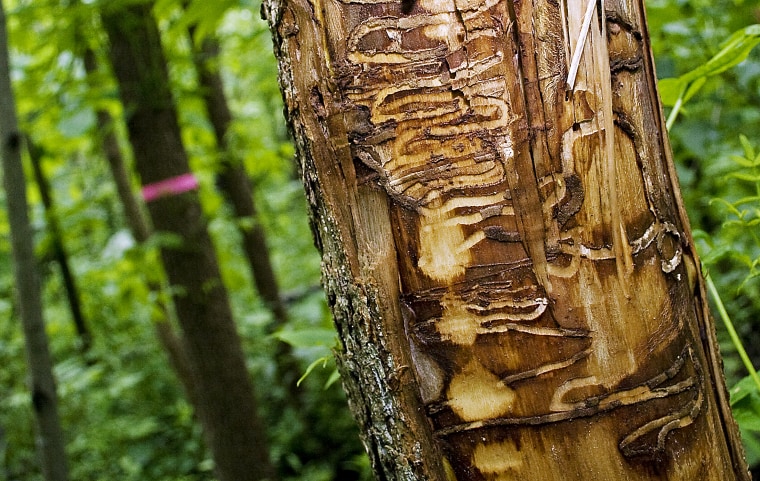Human activities such as deforestation and the burning of fossil fuels are by far the biggest contributors to climate change. But by killing trees that suck heat-trapping carbon dioxide from the air, certain bugs deserve a bit of blame — and a new study shows that invasive insects and diseases kill enough trees in the United States each year to release 6 million tons of carbon into the atmosphere.
That’s roughly equivalent to the tailpipe emissions of 4.4 million cars.
“They are like fire,” study co-author Songlin Fei, a forestry professor at Purdue University in West Lafayette, Indiana, said of the tree-killing species that have been introduced into the U.S. in recent decades. “They consume everything in their path.”
The study, published Aug. 12 in the journal Proceedings of the National Academy of Sciences, grew out of an observation Fei made in his own backyard. An ash tree there was dying — a victim of the emerald ash borer, a bright-green beetle originally from Asia whose bark-munching larvae have killed hundreds of millions of trees in the U.S. since the species was discovered stateside in 2002.
Fei wondered just how big a toll the beetles and other invasive species take on trees across the U.S. So, he and his collaborators decided to take a look at data collected by the U.S. Forest Service in 93,000 woodland parcels across the nation, focusing on damage done by the emerald ash borer and 14 other invasive species considered to be especially harmful to ash, elm, chestnut and other forest trees.
The researchers calculated tree mortality rates in pest-free areas, and then compared them to the rates in infested areas to determine the toll taken by the pests. On average, just more than 1 percent of trees in the U.S. die each year. The study showed that close to 3.5 percent died in ash borer-infested areas. For areas infested with other pests, like the laurel wilt fungus that infects laurel trees, more than 11 percent of trees died over the course of a year.
If the pests are allowed to continue unchecked, the scientists calculated, they could eventually kill or weaken a staggering 41 percent of the trees in the lower 48 states.
The consequences of such widespread devastation would extend far beyond the loss of valuable woodland habitat, according to Fei. “We think about forests as one of the major solutions for climate change,” he said. “When these trees are being damaged by these insects, they become dead materials. When they become dead materials, they not only stop working for you, they release CO2 back into the atmosphere.”
In other words, the invasive species pose a double threat to woodlands. They reduce trees' ability to sequester atmospheric carbon and, when dead trees decompose, cause more carbon to be released into the atmosphere.
Jill Wegrzyn, a professor who studies tree genetics at the University of Connecticut in Storrs, praised the study for shedding light on a problem that is sometimes overlooked. “It’s incredibly important,” she said. “The more that we understand about the true impact of these diseases, the more we’ll think about solutions at all levels.”
Wegrzyn said climate change could further raise the risk invasive species pose to U.S. forests. Drought and extreme weather can weaken trees’ immune systems, she said, making them more vulnerable to infection. And warmer weather encourages the spread of diseases that thrive in high temperatures.
Invasive species are a problem for trees the world over. But with more than 450 tree-feeding pests introduced to its forests through international travel and commerce, the U.S. is especially vulnerable. Given the threat, Fei said state foresters should continue monitoring woodlands for signs of disease and implementing protective measures like bans on moving infected wood.
Another way to protect forests is to create more resilient trees, like the fungus-resistant hybrid Chinese-American chestnut tree. Scientists are doing just that by introducing into native tree species genes from related species from the pests’ original ecosystems — which typically evolved to have a measure of resistance to the pests.
For Wegrzyn, an effective solution to the invasive species problem can’t come soon enough. “It is moving fast,” she said of the spread of the species. “It doesn’t just impact the biodiversity around you, it impacts the entire climate.”
Want more stories about the environment?
- Do airplane contrails contribute to climate change? Yes, and the problem is about to get worse.
- Climate change could trigger a global food crisis, new U.N. report says
- Scientists discover the world's biggest seaweed patch. They say it could be the 'new normal.'
SIGN UP FOR THE MACH NEWSLETTER AND FOLLOW NBC NEWS MACH ON TWITTER, FACEBOOK, AND INSTAGRAM.
